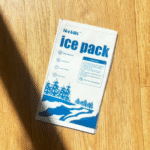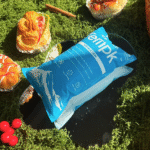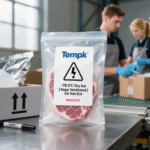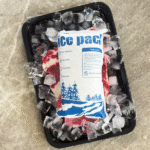In cold chain logistics, ensuring that temperature-sensitive goods arrive safely is crucial. Dry ice bricks and ice packs play an essential role in maintaining optimal temperatures during transit, reducing spoilage and enhancing cost-efficiency. This article explores their benefits and how they can transform your cold chain operations.
-
What makes dry ice bricks and ice packs ideal for cold chain logistics?
-
How do these tools compare to traditional ice solutions?
-
What are the environmental and economic advantages of using dry ice?
-
How can businesses leverage dry ice solutions for better logistics?
What Are Dry Ice Bricks and Ice Packs?
Dry ice bricks are solid blocks of frozen carbon dioxide (-78.5°C), and ice packs are flexible containers filled with a gel or water solution that freezes at 0°C. These cooling tools are used to maintain specific temperature ranges for sensitive products during transit, including pharmaceuticals, food, and biotech products.
Dry ice sublimates into gas, making it ideal for shipments requiring long-lasting, ultra-low temperatures, while ice packs are better suited for shorter trips and moderate temperature control needs.
Comparison of Cooling Methods
| Feature | Dry Ice Bricks | Ice Packs | Traditional Ice |
|---|---|---|---|
| Temperature | -78.5°C | 0°C to -5°C | 0°C to -5°C |
| Cooling Duration | 24-72 hours | 8-12 hours | 4-6 hours |
| Reusability | Yes | Yes | No |
| Waste Generation | Minimal | Low | High |
| Suitability for Long Shipments | Best suited for long shipments | Ideal for short shipments | Not ideal for extended transit |
Why Are Dry Ice Bricks and Ice Packs Better Than Traditional Ice?
No Water Damage: Dry ice sublimates into gas, preventing any water damage to your sensitive products, a common problem with traditional ice that melts during transit.
Longer Cooling Duration: Dry ice offers superior cooling for up to 72 hours, which is essential for long-distance or international shipments. In contrast, traditional ice lasts only a few hours, potentially risking spoilage.
Space Efficiency: Dry ice takes up less space than traditional ice, allowing for more efficient use of cargo space, especially in compact or tightly packed shipments.
How to Choose the Right Dry Ice Solution for Your Shipment
Choosing the right cooling method depends on the nature of your shipment:
-
For long-duration shipments: Dry ice bricks are ideal due to their ability to maintain ultra-low temperatures for an extended period.
-
For smaller or less temperature-sensitive shipments: Ice packs are cost-effective and work well for shorter trips.
-
For pharmaceuticals or temperature-sensitive items: Dry ice provides precise, reliable cooling over long distances, ensuring product integrity.
The Environmental Impact of Dry Ice Bricks and Ice Packs
As sustainability becomes a growing concern in logistics, both dry ice bricks and ice packs contribute to reducing the environmental impact of cold chain operations:
-
Dry Ice: Since it sublimates, it leaves no liquid waste, making it an environmentally friendly option compared to traditional ice or gel packs that generate significant waste.
-
Eco-Friendly Ice Packs: Many ice packs are made with biodegradable, non-toxic materials, reducing their environmental footprint when compared to conventional plastic-based solutions.
Trends in Cold Chain Logistics: 2025 and Beyond
The cold chain industry is evolving, with new trends focused on sustainability and efficiency:
-
IoT and Real-Time Monitoring: The integration of IoT devices for temperature tracking ensures that dry ice solutions work effectively and helps businesses respond to temperature fluctuations immediately.
-
Smarter Packaging Solutions: Advances in packaging technology are helping enhance the cooling performance of dry ice, reducing overall shipping costs and increasing efficiency.
-
Sustainability Innovations: Companies are developing biodegradable dry ice options and seeking eco-friendly certifications to appeal to environmentally-conscious consumers.
Frequently Asked Questions
How long do dry ice bricks and ice packs last?
Dry ice can maintain a low temperature for 18-72 hours, depending on the shipment size and conditions. Ice packs last between 8-12 hours. Proper insulation and packaging can help maximize their effectiveness.
Can dry ice bricks and ice packs be reused?
Yes, both dry ice bricks and many types of ice packs are reusable. However, dry ice generally cannot be reused for the same shipment as it sublimates, but the material itself can be recycled for other uses.
Conclusion and Recommendations
Dry ice bricks and ice packs are integral to maintaining efficient, cost-effective cold chain logistics. By using the appropriate solution, businesses can reduce spoilage, enhance product safety, and optimize shipping costs. For longer shipments or highly temperature-sensitive goods, dry ice is the best solution. For shorter, less sensitive shipments, ice packs provide an affordable and sustainable alternative.
Next Steps:
-
Evaluate your cold chain needs: Assess your specific shipping requirements and determine which solution works best for your business.
-
Monitor your shipments: Implement temperature tracking tools to ensure your cold chain solutions maintain optimal conditions during transit.
About Tempk
At Tempk, we specialize in providing high-performance cold chain solutions. Our dry ice bricks and ice packs offer superior temperature control, cost savings, and sustainability. Contact us today to learn how we can help optimize your logistics operations with our innovative cooling solutions.























